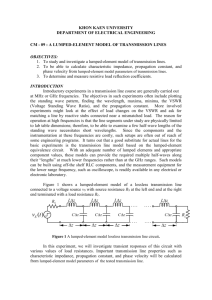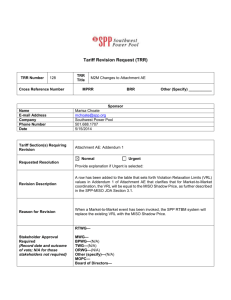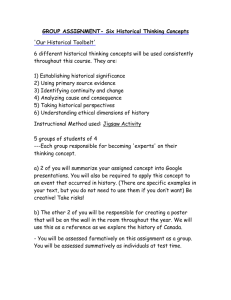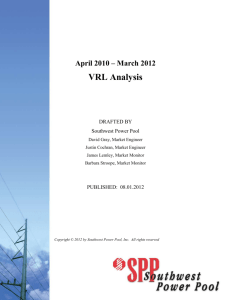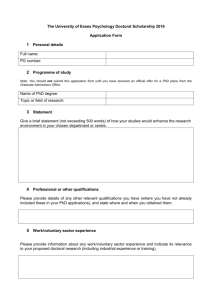X4L SDiT - Tutor Guide
advertisement
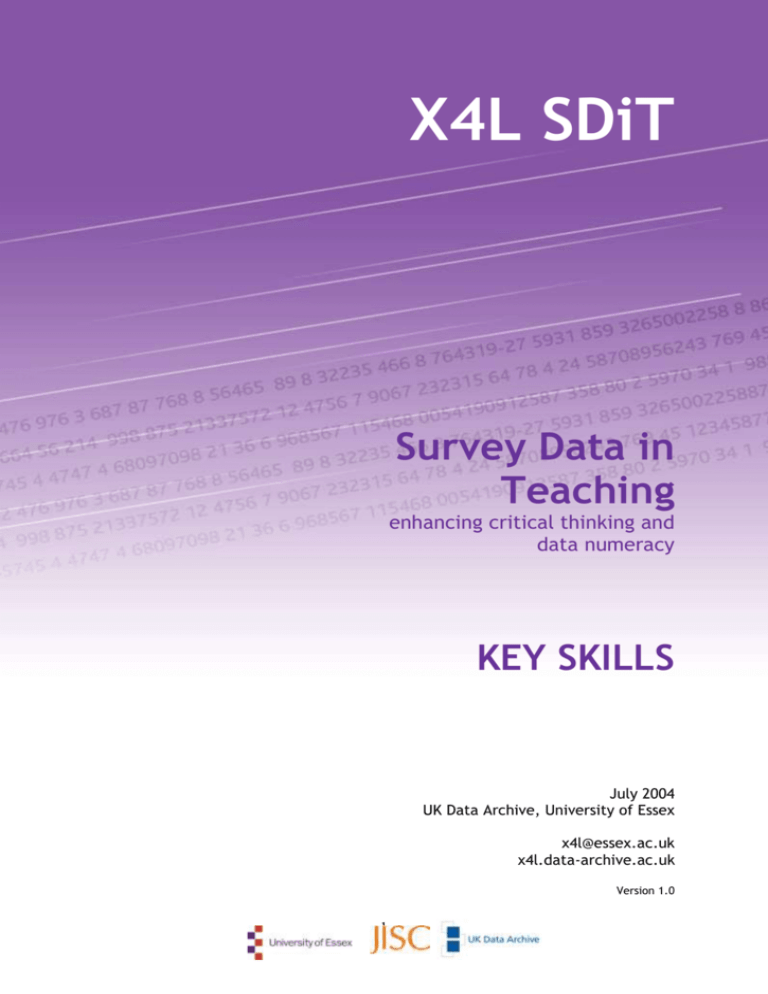
X4L SDiT Survey Data in Teaching enhancing critical thinking and data numeracy KEY SKILLS July 2004 UK Data Archive, University of Essex x4l@essex.ac.uk x4l.data-archive.ac.uk Version 1.0 1 Key Skills mapping X4L Survey Data in Teaching – Key Skills 2 Key Skills mapping These resources are relevant to many of the Qualifications and Curriculum Authority (QCA) Key Skills requirements, for Level 3 and beyond. What follows in this section is an approximate mapping of the resources to Key Skills Level 3. The following web sites were consulted in constructing these mappings: www.qca.org.uk/14-19 www.keyskillssupport.net www.keyskills4u.com Key Skills (as defined by the QCA) are an integral part of educational programmes at Key Stage 4, post-16 and of modern apprenticeships. There are six Key Skills, each of which is available at levels 1 to 4 of the National Qualifications Framework. While levels 1 and 2 are appropriate to GCSE and GNVQ, and to NVQ levels 1-3, it is Key Skills level 3, which is appropriate for AS, A level, VCE, or NVQ level 3, with which we are concerned here. ‘Level 3 marks a shift from being able to deal with routine tasks, to being capable of responding to the demands of more complex activities. Units at level 3 require more explicit reasoning ability and increased personal autonomy in making decisions about their learning and how tasks are organized’ Web site for Key Skills Support Programme, funded by the Department for Education and Skills The three Key Skills qualifications are: Communication Application of Number Information Technology which are assessed through a portfolio of the student’s work, both internally and also by an external test, marked by an awarding body. The three wider Key Skills are: Working with Others Improving own Learning and Performance Problem Solving which are assessed internally though a portfolio, but without testing. These skills are highly valued by employers and by universities. Key Skills underpin much of school and college (and also university) learning experience. These resources can help students work on their communicating skills, their handling of and confidence in using numbers and IT, problem solving skills, and working in groups. Key Skills proficiency also count towards university, as UCAS awards points for the three Key Skills qualifications. X4L Survey Data in Teaching – Key Skills 3 ‘A survey of UCAS offers made in 2002 showed that around 50% of the offers made by Higher Education Institutions (not counting the older universities) allowed key skills points to be counted. For entry in 2003, about one third of the 45 000 courses on the UCAS database are set to accept key skills tariff points.’ Web site for Key Skills Support Programme, funded by the Department for Education and Skills It is generally recognized that there are three stages in doing Key Skills: learning the underpinning techniques (for example English, IT, or problem solving); practising and developing the skills; using and applying the skills to get things done.; For the three Key Skills qualifications, students must complete a portfolio of evidence and pass a test. For the wider Key Skills only the portfolio is required. These resources can help contribute to all three stages in the doing of Key Skills, but could also be included in the portfolio e.g. completed exercises and printouts etc. Confidence in the handling of datasets, in manipulating numbers and in understanding statistics does not come to every student so easily. These resources are intended to start from first principles by looking at the issues in a real life setting. Thus the Key Skills learned are done so in a more contextualised way – hopefully, one with meaning and applicability to the real world! Mapping of SDiT resources to Key Skills Level 3 The table below sets out a mapping of the activities and exercises in the modules to the Key Skills of interest. For reference, the actual Key Skills requirements (at Spring 2004) are set out in the section following the table. X4L Survey Data in Teaching – Key Skills 4 Key Skills requirement by SDiT module Module 1 Communications Group discussion skills Module 2 Group discussion skills Module 3 Group discussion skills Module 4 Information Technology Application of number Internet usage Internet usage Line graph reading skills Interpretation of trends Working With Others Problem solving Improving own learning and performance Comprehension of basic measurement guidelines Use of computer program for recoding data Resource discovery on the web Use of internet to explore metadata Use of computer program for data analysis Finding surveys at the UK Data Archive Use of data analysis package to generate descriptive statistics, graphs and univariate tables Data analysis of 2-way tables Exploring the Social Science Information Gateway (SOSIG) Understanding of basic descriptive statistics and frequency tables Group exercises Group exercises Understanding of concepts of operationalisation and validity where used as self-paced learning or assessed Problem analysis and evaluation skills Understanding of theoretical concepts and evaluation of evidence Evaluation of sources of data where used as selfpaced learning or assessed where used as self-paced learning or assessed Examining associations between two variables Making and interpreting Presenting and analysing straightforward tables and data in tables graphs Understanding of Describing large sets of concepts of association numbers using only one or and independence two numbers Manipulating data More complex graphical analysis (stacked bar charts, time indices, paired bar charts) Group exercises Module 6 Citing references and sources properly Presenting and reporting back on data analysis Understanding of content and usage of metadata Trend comparison Module 5 Analysing results from data analysis where used as selfpaced learning or assessed Introduction to the online data system Nesstar Accessing and browsing data using online resources Familiarity with the British Crime Survey dataset and variable frequencies Producing tables and graphs Exploring data with a hypothesis in mind where used as selfpaced learning where used as selfpaced learning Key Skills specifications (Spring 2004) Communication C3.1b Make a presentation about a complex subject, using at least one image to illustrate complex points. speak clearly and adapt your style of presentation to suit your purpose, subject, audience and situation structure what you say so that the sequence of information and ideas may be easily followed use a range of techniques to engage the audience, including effective use of images C3.2 Read and synthesise information from two extended documents about a complex subject. One of these should include at least one image. select and read material that contains the information you need identify accurately, and compare, the lines of reasoning and main points from texts and images synthesise the key information in a form that is relevant to your purpose C3.3 Write two different types of documents about complex subjects. One piece of writing should be an extended document and include at least one image. select and use a form and style of writing that is appropriate to your purpose and complex subject matter organise relevant information clearly and coherently, using specialist vocabulary when appropriate ensure your text is legible and your spelling, grammar and punctuation are accurate, so your meaning is clear C4 develop a strategy for using a variety of oral, visual and written forms of communication monitor and critically reflect on progress evaluate their overall strategy and present the outcomes of their work. Information and Communication Technology IT3.1 Plan and use different sources to search for, and select, information required for two different purposes. X4L Survey Data in Teaching – Tutor Guide plan how to obtain and use the information required to meet the purpose of your activity choose appropriate sources and techniques for finding information and carry out effective searches make selections based on judgements of relevance and quality IT3.2 Explore, develop and exchange information, and derive new information, to meet two different purposes. enter and bring together information in a consistent form, using automated routines where appropriate create and use appropriate structures and procedures to explore and develop information and derive new information use effective methods of exchanging information to support your purpose IT3.3 Present information from different sources for two different purposes and audiences. Your work must include at least one example of text, one example of images and one example of numbers. develop the structure and content of your presentation using the views of others, where appropriate, to guide refinements ensure your work is accurate and makes sense IT4 develop a strategy for using a variety of ICT skills monitor and critically reflect on progress evaluate their overall strategy and present the outcomes from their work. Application of number N3.1 Plan and interpret information from two different types of sources, including a large data set. plan how to obtain and use the information required to meet the purpose of your activity obtain the relevant information choose appropriate methods for obtaining the results you need and justify your choice N3.2 Carry out multi-stage calculations to do with: 1. amounts and sizes; 2. scales and proportion; 3. handling statistics; 4. rearranging and using formulae. 6 You should work with a large data set on at least one occasion. carry out calculations check methods and results to help ensure errors are found and corrected N3.3 Interpret results of your findings and justify your methods. You must use at least one graph, one chart and one diagram. select appropriate methods of presentation and justify your choice present your findings effectively explain how the results of your calculations relate to the purpose of your activity N4 develop a strategy for using a variety of skills in application of number monitor and critically reflect on progress evaluate their overall strategy and present the outcomes of their work. Working with others WO3.1 Plan complex work with others, agreeing objectives, responsibilities and working arrangements. agree realistic objectives for working together and what needs to be done to achieve them exchange information, based on appropriate evidence, to help agree responsibilities agree suitable working arrangements with those involved WO3.2 Seek to establish and maintain cooperative working relationships over an extended period of time, agreeing changes to achieve agreed objectives. exchange accurate information on progress of work, agreeing changes where necessary to achieve objectives organise and carry out tasks so you can be effective and efficient in meeting your responsibilities and produce the quality of work required seek to establish and maintain cooperative working relationships, agreeing ways to overcome any difficulties WO3.3 Review work with others and agree ways of improving collaborative work in the future. X4L Survey Data in Teaching – Tutor Guide agree the extent to which work with others has been successful and the objectives have been met identify factors that have influenced the outcome agree ways of improving work with others in the future Improving own learning and performance LP3.1 Agree targets and plan how these will be met over an extended period of time, using support from appropriate people. seek information on ways to achieve what you want to do, and identify factors that might affect your plans use this information to agree realistic targets with appropriate people plan how you will effectively manage your time and use of support to meet targets, including alternative action for overcoming possible difficulties LP3.2 Take responsibility for your learning by using your plan, and seeking feedback and support from relevant sources, to help meet targets. Improve your performance by: studying a complex subject leaning through a complex practical activity further study or practical activity that involves independent learning. seek and actively use feedback and support from relevant sources to help you meet targets select and use different ways of learning to improve your performance, adapting approaches to meet new demands manage your time effectively to complete tasks, revising your plan as necessary LP3.3 Review progress on two occasions and establish evidence of achievements, including how you have used learning from other tasks to meet new demands. provide information on the quality of your learning and performance, including factors that have affected the outcome identify targets you have met, seeking information from relevant sources to establish evidence of your achievements exchange views with appropriate people to agree ways to further improve your performance 7 Problem solving PS3.1 Explore a complex problem, come up with three options for solving it and justify the option selected for taking forward. explore the problem, accurately analysing its features, and agree with others on how to show success in solving it select and use a variety of methods to come up with different ways of tackling the problem compare the main features of each possible option, including risk factors, and justify the option you select to take forward PS3.2 Plan and implement at least one option for solving the problem, review progress and revise your approach as necessary. plan how to carry out your chosen option and obtain agreement to go ahead from an appropriate person implement your plan, effectively using support and feedback from others review progress towards solving the problem and revise your approach as necessary PS3.3 Apply agreed methods to check if the problem has been solved, describe the results and review your approach to problem solving. agree, with an appropriate person, methods to check if the problem has been solved apply these methods accurately, draw conclusions and fully describe the results review your approach to problem solving, including whether alternative methods and options might have proved more effective X4L Survey Data in Teaching – Tutor Guide 8 X4L SDiT Project UK Data Archive, University of Essex Wivenhoe Park, Colchester Essex Tel: +44 (0) 1206 872145 Email: x4l@essex.ac.uk x4l.data-archive.ac.uk

